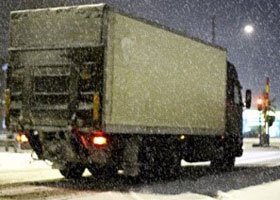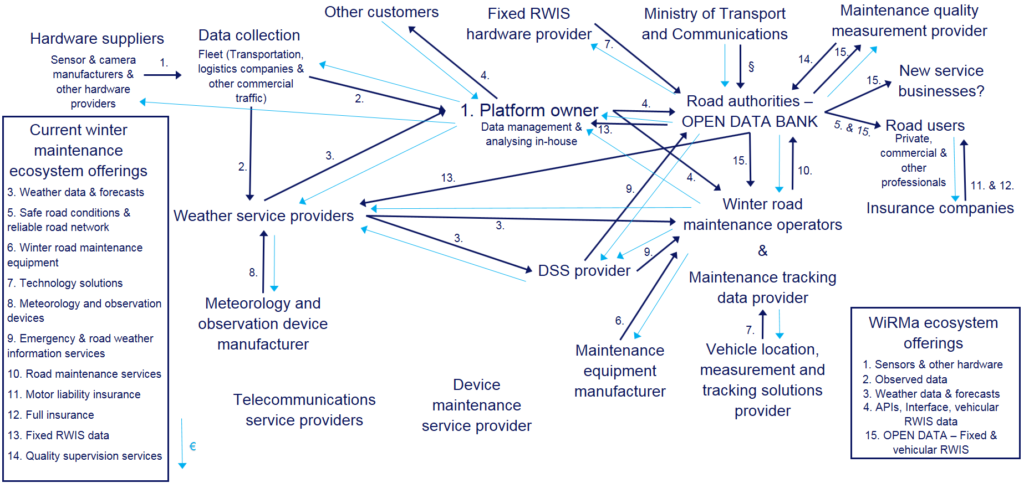In the WiRMa- (Industrial Internet Applications in Winter Road Maintenance) project, new vehicular road condition data observation methods are tested and studied. Such novel innovations and services require working business models and commitment of the business actors. A recent master’s thesis introduces the business ecosystem of WiRMa.
Vehicular Road Weather Information System
New weather observation methods have to be invented and studied as current observation methods are not accurate enough on the whole road network. For example in northern Finland, the distance between the road weather stations can be over 200 kilometres. The issue is to know what conditions occur between the scattered road weather stations. Road weather stations are expensive so it might not be feasible to cover more roads with them, but new solutions could provide more extensive information with better cost efficiency.

Photo: VTT
The WiRMa-project, coordinated by Lapland University of Applied Sciences, introduces an open data platform that is used to merge multiple road weather data sources into one application. The purpose of the platform is to test multiple different sensors and other road condition observation methods. These technologies measure, for example, road surface condition and temperature, slipperiness, air humidity and temperature. The vehicular data is collected with commercial and professional vehicles that operate in Finnish Lapland this winter. The WiRMa platform is planned to be exploited especially for winter road maintenance, but one of the goals is also for example the development of weather forecasts. The aim of the platform is to enhance traffic safety, allocate maintenance operations more timely and to create new businesses.
The data produced is in principle similar to fixed Road Weather Information System (RWIS) that is widely used to observe road conditions continuously. Fixed RWIS is also one of the main tools used in decision support for winter road maintenance. Hence, the purpose of the vehicular data is to provide more information to decision-making situations of winter road maintenance. The similarities to fixed RWIS is also the reason why the thesis calls vehicular data collection system, such as the WiRMa platform, as a vehicular RWIS.
Business ecosystem of WiRMa
To work properly and to be a viable option, the WiRMa platform requires a complex business network, a business ecosystem, to be formed around the platform. This ecosystem consists of multiple business actors, who all have different value offerings and customers in the ecosystem. However, end customers are the same to everyone as the aim is to produce road condition information. Figure 1 is an illustration of the WiRMa business ecosystem as a part of current winter road maintenance business ecosystem. In Figure 1, the dark blue lines represent the offerings and light blue lines describe the monetary transactions.

Figure 1. Value network of Finnish winter road maintenance ecosystem with WiRMa ecosystem (Lusikka 2018).
The described business ecosystem is only a mere example of the pilot stage ecosystem, and it is not a commercial ecosystem. The purpose of the thesis was to identify the business actors and capabilities that are needed to construct a viable ecosystem around the platform and describe the possible value creation of the ecosystem. To ensure the continuity of platforms all ecosystem actors need to commit to the platform, as without the commitment, required investments might not take a place. In addition, the thesis pointed out that in Finland, road authorities have a major role in road weather ecosystems as they procure road maintenance services and offer extensive weather data (e.g. fixed RWIS) free of charge to maintenance providers.
Further research
Furthermore, the thesis provided some knowledge of costs and benefits of the WiRMa system, and the research has continued after the thesis to study the costs and benefits more widely. The purpose of the further research is to explore cost effectiveness of vehicular RWIS. In addition, it has to be figured out, whether the commercial ecosystems will prevail with described transactions, or whether the commercial market will organize the ecosystem differently.
The thesis “Business Ecosystem Analysis of a Vehicular Road Weather Information System –case WiRMa” (in English).
The project is financed by the Interreg Nord Programme, Regional Council of Lapland (FI) and Region Norrbotten (SE).
 Contact:
Contact:
Toni Lusikka
toni.lusikka@vtt.fi
VTT Technical Research Centre of Finland, Finland






Follow us: